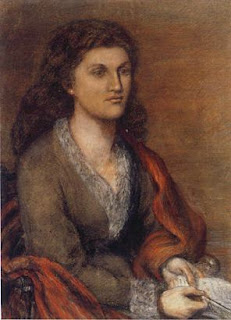Two significant artists were missing from my recent Pre-Raphaelite Sisters exhibition at the National Portrait Gallery. Omitted owing to an already over-crowded cast-list, their absence was especially regretted as these two were literal not metaphorical sisters.
Half-sisters, to be precise. Lucy and Catherine were daughters of Ford Madox Brown, the doyen or daddy of the PRB, who declined to join the band because of its juvenile title, but who provided close support to the Pre-Raphaelite aims.

And so I am especially delighted that they feature in dual perspective in the Uncommon Power exhibition at the Watts Gallery Compton opening on 26 September.
Both produced modest but accomplished and original works, which are virtually unknown as they remain in private hands. Descendants have been proud to retain the sisters’ pictures, according to exhibition curator Ruth Brimacombe. So the new exhibition offers a rare opportunity to view hitherto unseen works by the ‘lost Pre-Raphaelites’ Lucy Madox Brown and Catherine Madox Brown.

Lucy’s early work The Duet, (RA 1870) presents an unexpected 18th century scene with elements of chinoiserie, but her preferred subjects were drawn from drama and history – notably Romeo at the Tomb, Ferdinand and Miranda playing chess from Shakespeare and The Magic Mirror, from a legend about the Earl of Surrey by Thomas Nashe [at top]. All were marked by distinctive imagination and, especially, fine colour effects, they extend the Pre-Raphaelite canon in respect of both style and content. The Magic Mirror (aka Fair Geraldine) is especially welcome – theme and handling wholly within the PR mode, yet the subject quite original.
Cathy’s companion portraits of her parents deserve wider circulation, although only that of her father is included in the exhibition. She perhaps had more natural artistic talent, endowing portraits and contemporary genre scenes with visual interest and harmonies, yet more conventional subject choices. The child puzzling over the sum 9+6 on her slate in A Deep Problem (1875, BMAG) combines charm, observation and empathy. At The Opera (1869) is a stunning take on the usually formulaic half-length female with decorative accessories. Was Marie Spartali the model?
Curator
and Gallery have made the most of the limited space available, with a richness
and variety of exhibits, almost all unknown to viewers. Moreover, the sisters’ relatively small
output, together with its relatively high quality, make this first exhibition
of their works a great chance to assess and indeed establish their place within
the Pre-Raphaelite movement. How do
their pictures compare? What adjustments
to the critical history do they provoke?






No comments:
Post a Comment